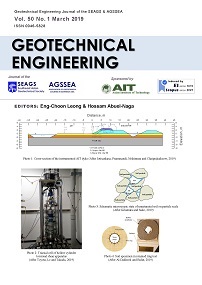Water Retention and Unsaturated Hydraulic Behaviors of a Biochar-modified Silt
Main Article Content
Abstract
Biochar has been used to modify the soil cover of municipal solid waste (MSW) landfill to mitigate methane emission. To model the coupled water and reactive gas transport in unsaturated soil cover, water retention curve and unsaturated permeability function of biochar-modified soil cover are required. A laboratory study is presented to investigate the effects of biochar content (BC) and void ratio on the water retention and unsaturated hydraulic behaviors of a biochar-modified silt. Biochar contains high internal porosities and it exhibits negative surface charge. Adding biochar to the silt alters the microstructures of modified soil. The pore size distributions measured by the mercury intrusion porosimetry indicate that the modified silt contains more micro-porosities than the untreated silt. Results of modified evaporation test showed that water retention capacity increases with increasing BC. In other words, the modified silt can hold more water for a given suction. On the other hand, the modified silt exhibits a lower saturated permeability and also a lower rate of change in permeability with respect to suction. Despite the modified silt is less permeable than the untreated silt in the low suction regime, it becomes more permeable after drying to the high suction regime.
Article Details

This work is licensed under a Creative Commons Attribution-NonCommercial-NoDerivatives 4.0 International License.
Copyright © 2019 Association of Geotechnical Societies in Southeast Asia (AGSSEA) - Southeast Asian Geotechnical Society (SEAGS).


